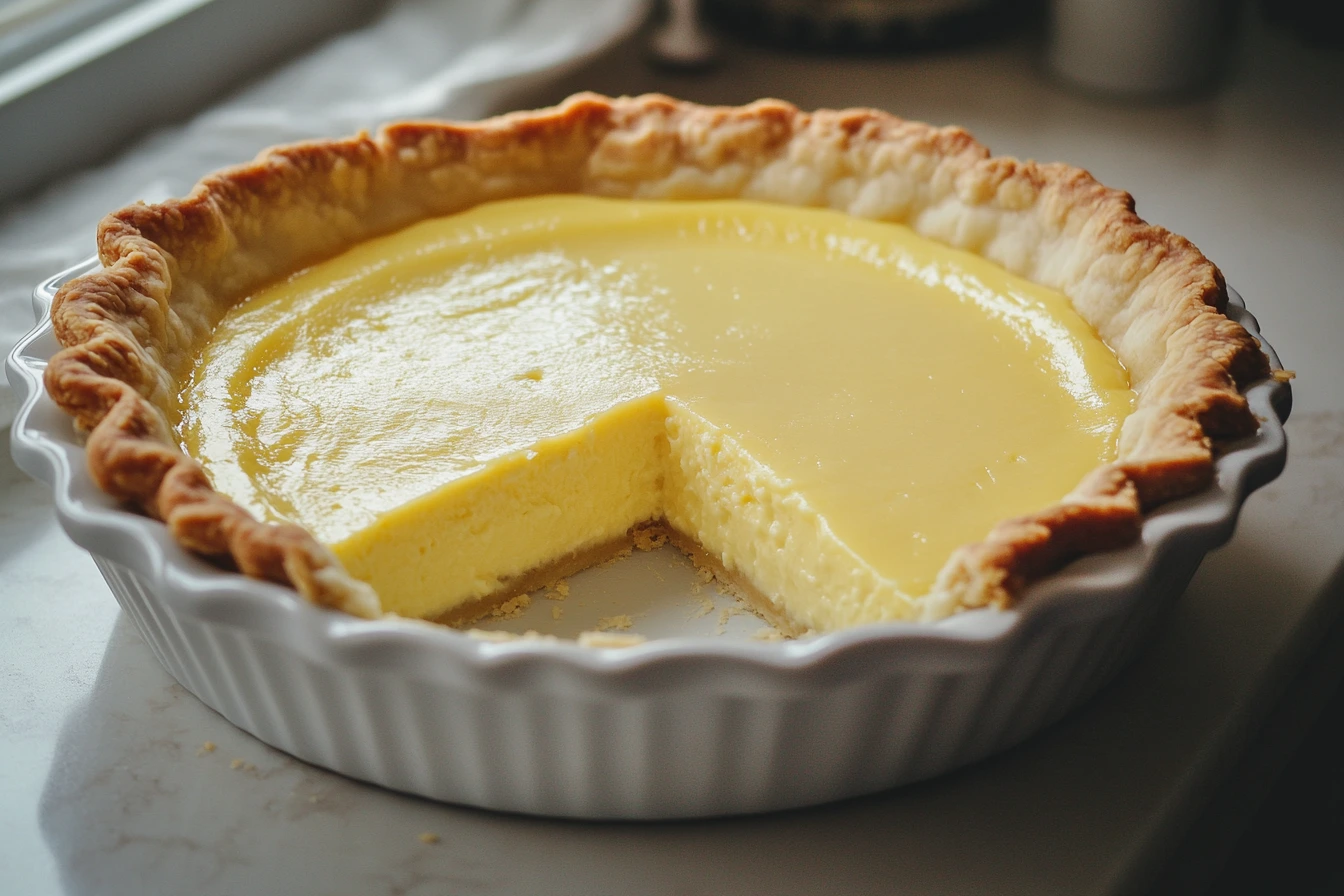There’s something profoundly comforting about an Old Fashioned Custard Pie. This beloved dessert has graced American tables for generations, representing a perfect harmony of simplicity and elegance. With its silky smooth texture, delicate vanilla flavor, and perfectly flaky crust, an Old Fashioned Custard Pie embodies the essence of traditional baking at its finest.
What makes this Custard Pie special is not complexity or elaborate technique, but rather its honest, straightforward approach. The magic happens when humble ingredients—milk, eggs, sugar, and vanilla—transform through gentle heating into a luscious, trembling custard that’s simultaneously rich and light. This dessert doesn’t rely on bells and whistles; instead, it showcases the beauty of perfecting the basics.
Table of Contents
Understanding the Magic of Old Fashioned Custard Pie
At its heart, a traditional Old Fashioned Custard Pie consists of a creamy egg and milk-based filling baked inside a pastry crust until just set. Unlike many modern desserts that layer flavors and textures for complexity, an Old Fashioned Custard Pie embraces simplicity. It relies on the subtle interplay between sweet, creamy custard and buttery, flaky crust to create a dessert that’s greater than the sum of its parts.
Custard Pies have deep historical roots in American cuisine, tracing back to European settlers who adapted their traditional recipes to ingredients available in the New World. Once a staple in farmhouse kitchens where fresh milk and eggs were plentiful, these pies became beloved fixtures at family gatherings, church socials, and holiday tables. The recipe for Old Fashioned Custard Pie was passed down through generations, often by demonstration rather than written instruction, creating slight variations across regions and families.
Ingredients for Perfect Old Fashioned Custard Pie
For the Flaky Pie Crust:
- 1 1/4 cups all-purpose flour
- 1/4 teaspoon salt
- 1/3 cup cold unsalted butter, cubed
- 1/4 cup cold vegetable shortening, cubed
- 3-4 tablespoons ice water

For the Silky Custard Filling:
- 2 1/2 cups whole milk
- 4 large eggs
- 2/3 cup granulated sugar
- 1/4 teaspoon salt
- 1 1/2 teaspoons pure vanilla extract
- 1/4 teaspoon freshly grated nutmeg, plus more for garnish
- 1 tablespoon unsalted butter, melted and cooled
The Science Behind Perfect Custard Pie
Understanding a few key principles helps create the perfect Old Fashioned Custard Pie. Custard is essentially a delicate balance of proteins and fats suspended in liquid, set by the coagulation of egg proteins. The key challenge lies in achieving the perfect set—firm enough to slice cleanly yet tender enough to quiver slightly when the plate is tapped.
Temperature control is crucial when making Custard Pie. Overheating causes the proteins to contract too quickly, squeezing out liquid and resulting in a curdled, watery custard. Gentle, even heating allows the proteins to form a delicate network that traps moisture, creating that sought-after silky texture in your Old Fashioned Custard Pie.
The ratio of eggs to milk is equally important in a traditional Custard Pie. Too many eggs create a rubbery texture, while too few result in a custard that fails to set properly. The recipe presented here has been tested repeatedly to achieve the ideal balance for a custard that’s firm yet creamy.
Step-by-Step Instructions
Preparing the Perfect Pie Crust for Custard Pie
Begin by combining flour and salt in a large bowl. Add the cold cubed butter and shortening. Using a pastry cutter or your fingertips, work the fats into the flour until the mixture resembles coarse crumbs with some pea-sized pieces remaining. The varying sizes of fat pieces create layers in the dough that translate to flakiness in the baked crust of your Old Fashioned Custard Pie.
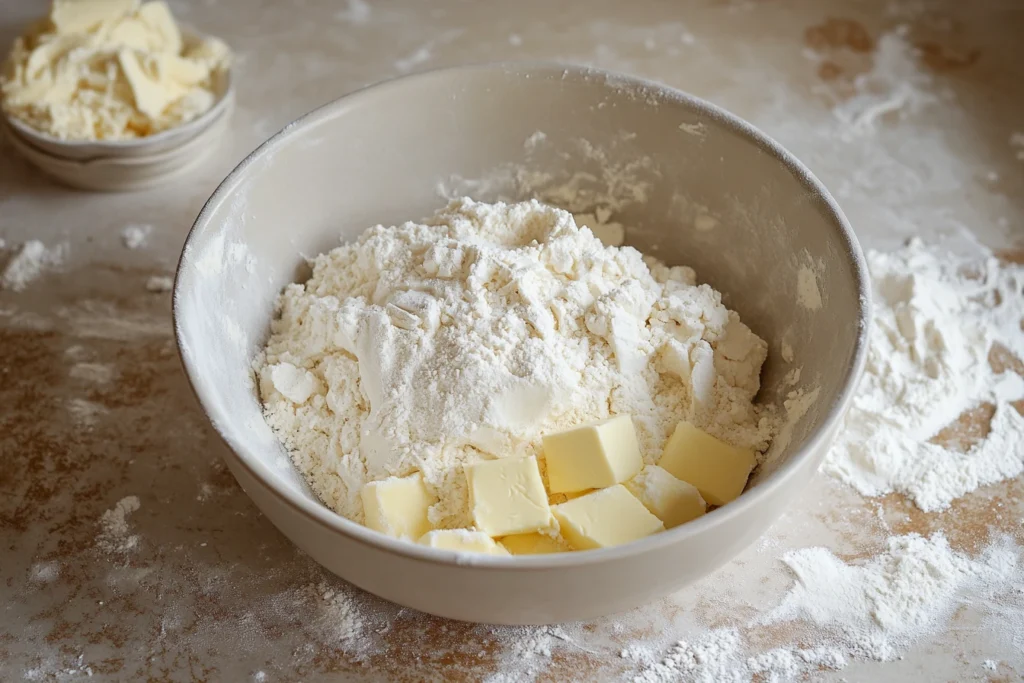
Sprinkle ice water over the mixture, 1 tablespoon at a time, tossing with a fork until the dough begins to hold together when pressed. Be careful not to add too much water or overwork the dough, as this develops gluten and results in a tough crust.
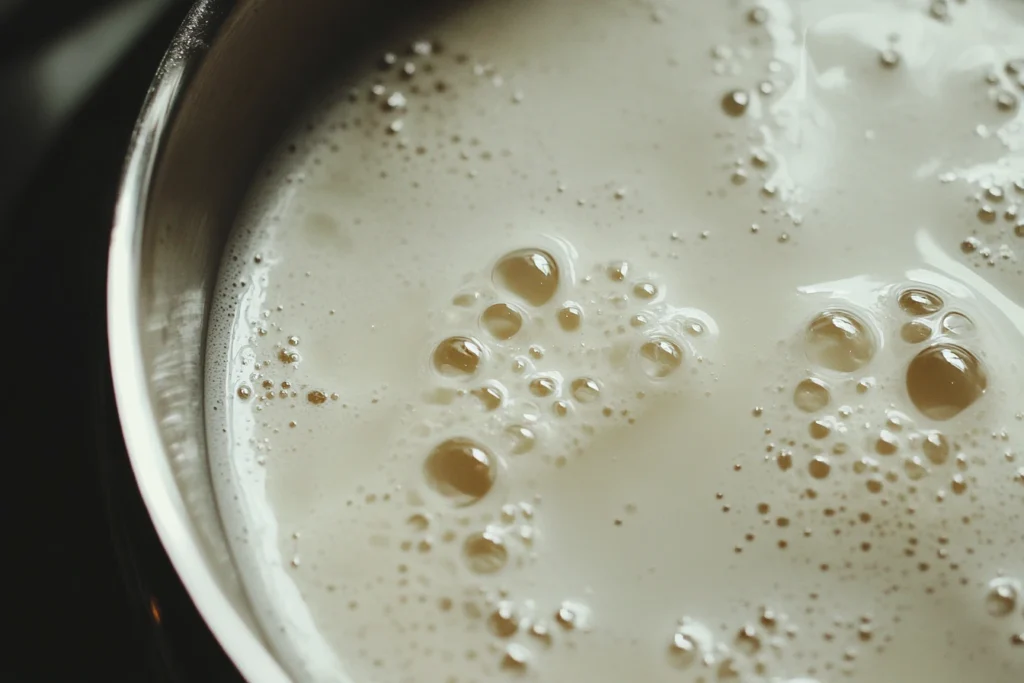
Form the dough into a disk, wrap in plastic, and refrigerate for at least 1 hour. This chilling step is crucial—it relaxes the gluten and allows the fats to solidify, which is essential for achieving flakiness in your Custard Pie crust.
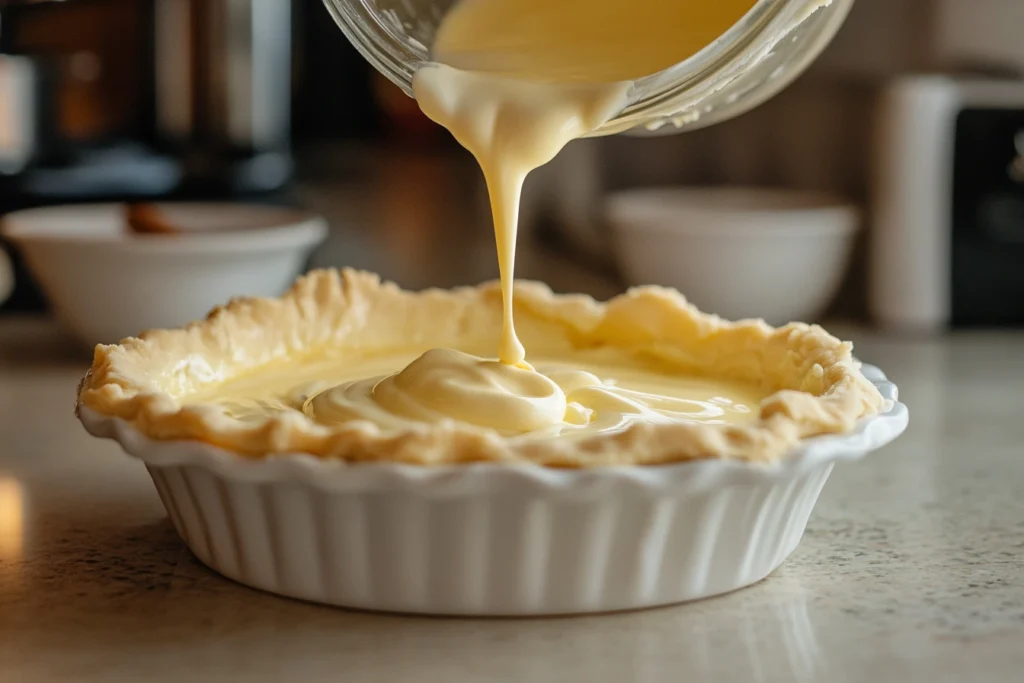
After chilling, roll the dough on a lightly floured surface to a 12-inch circle, about 1/8 inch thick. Carefully transfer to a 9-inch pie plate, trim the excess leaving a 1-inch overhang, then fold under and crimp decoratively. For best results, chill the shaped crust for 30 minutes before blind baking.
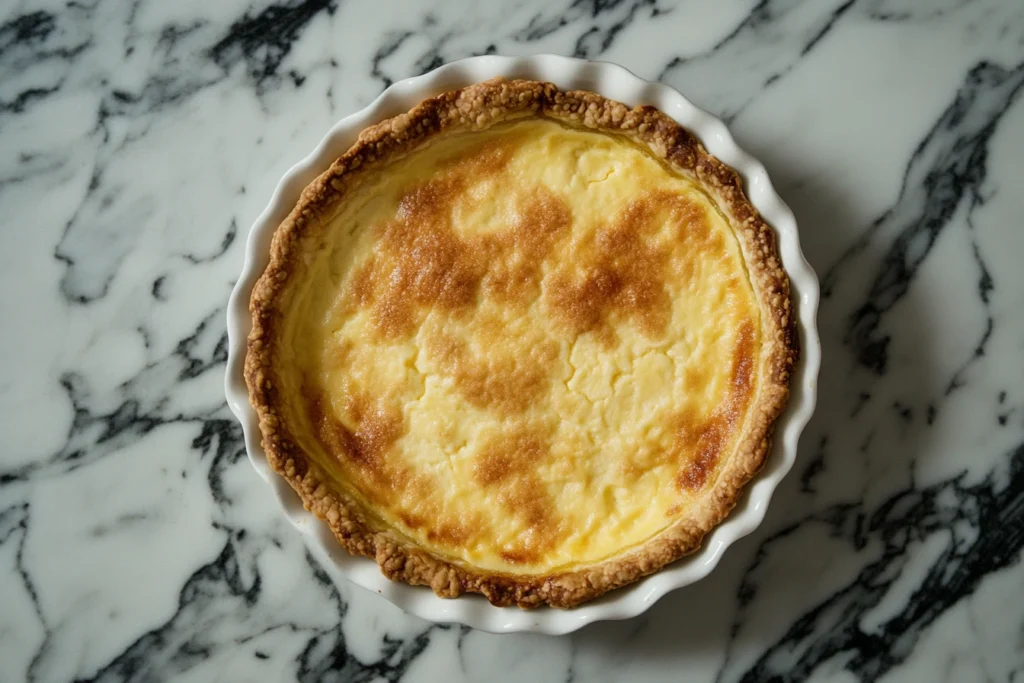
Preheat your oven to 375°F (190°C). Line the chilled crust with parchment paper and fill with pie weights or dried beans. Bake for 15 minutes, then remove the weights and parchment and bake for an additional 5-7 minutes until the bottom appears dry but not browned. This partial baking ensures the bottom crust of your Old Fashioned Custard Pie doesn’t become soggy from the wet filling.
Creating the Silky Custard Filling
While the crust is baking, prepare your filling. In a medium saucepan, heat the milk until small bubbles form around the edges—this is called scalding. Be careful not to boil, as this can alter the milk proteins and affect the final texture of your Custard Pie.
In a large bowl, whisk the eggs thoroughly. Gradually add sugar and salt, whisking until the mixture lightens slightly in color. This incorporates air, which helps create a lighter texture in the finished Old Fashioned Custard Pie.
Very gradually, pour the hot milk into the egg mixture in a slow, steady stream while whisking constantly. This technique, called tempering, gradually raises the temperature of the eggs without cooking them. Add the vanilla extract, nutmeg, and melted butter, whisking to combine.
Strain the mixture through a fine-mesh sieve into a clean bowl. This removes any bits of coagulated egg or undissolved sugar, ensuring a perfectly smooth custard for your Old Fashioned Custard Pie.
Baking Your Custard Pie
Reduce the oven temperature to 325°F (165°C). Place the partially baked pie shell on the center rack of the oven, then carefully pour the custard mixture into the shell. The lower temperature is crucial for gentle cooking, which creates the silkiest texture in your Custard Pie.
Bake for 35-40 minutes, or until the custard is almost set but still slightly jiggly in the center. A knife inserted about 1 inch from the center should come out clean. The residual heat will continue cooking the custard as it cools.
Allow the pie to cool completely on a wire rack, then refrigerate for at least 2 hours or overnight before serving. This setting time is essential for the Old Fashioned Custard Pie to fully develop its flavor and texture.
Serving Your Old Fashioned Custard Pie
Custard Pie is traditionally served chilled, though some prefer it closer to room temperature to fully appreciate the delicate flavors. Before serving, you might dust the top with a little additional freshly grated nutmeg for visual appeal and an extra aromatic dimension.
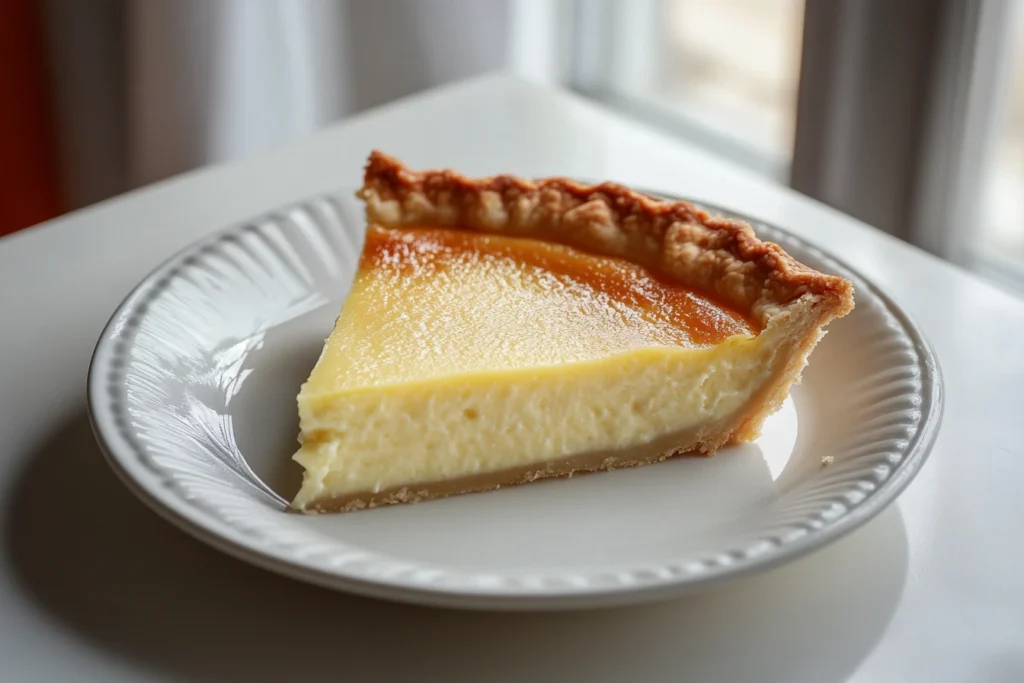
While this Old Fashioned Custard Pie stands beautifully on its own, it pairs wonderfully with seasonal berries or a dollop of lightly sweetened whipped cream. For an elegant presentation, consider garnishing with thinly sliced fresh berries, a sprig of mint, or a light dusting of powdered sugar.
Traditional Variations of Custard Pie
The beauty of Old Fashioned Custard Pie lies in its adaptability while maintaining its essential character. Here are some traditional variations you might explore:
Nutmeg vs. Cinnamon
While nutmeg is the traditional spice for Custard Pie, cinnamon makes a wonderful alternative, lending a warmer, more familiar flavor profile. Some family recipes call for a combination of both spices for added dimension in their Old Fashioned Custard Pie.
Buttermilk Custard Pie
Substituting buttermilk for regular milk creates a pie with a subtle tanginess that balances the sweetness. When using buttermilk in your Old Fashioned Custard Pie, reduce the amount to 2 cups and add an extra tablespoon of butter to maintain richness.
Chess Pie Connection
Some Southern variations incorporate cornmeal (about 1 tablespoon) and a tablespoon of vinegar into the custard, creating something between a traditional Custard Pie and a chess pie. This addition gives the filling a slightly grainy texture and more pronounced tang.
Troubleshooting Common Issues with Custard Pie
Even experienced bakers occasionally encounter challenges when making Old Fashioned Custard Pie. Here are solutions to common problems:
Weeping or Watery Custard
This typically results from overcooking your Custard Pie. The egg proteins contract too much, squeezing out liquid. Prevent this by watching your pie carefully and removing it from the oven when the center still has a slight jiggle. Also, avoid baking at too high a temperature.
Cracks in the Surface
Cracks usually indicate overcooking or cooling too quickly. Again, remove the Old Fashioned Custard Pie when the center is still slightly jiggly, and allow it to cool gradually at room temperature before refrigerating.
Soggy Bottom Crust
This common issue has several solutions. Make sure to blind bake your crust properly, and consider brushing the partially baked crust with a thin layer of egg white before adding the filling. The egg white creates a barrier that helps prevent sogginess in your Custard Pie.
Uneven Browning
If your Old Fashioned Custard Pie browns unevenly, your oven may have hot spots. Rotate the pie halfway through baking, and consider using a pie shield or aluminum foil to protect the edges from over-browning.
Make-Ahead and Storage Tips for Custard Pie
One of the benefits of Old Fashioned Custard Pie is that it actually improves with a rest in the refrigerator, making it perfect for advance preparation. The pie can be prepared up to two days ahead and kept refrigerated, covered loosely with foil after the pie has completely cooled.
For best results, remove the Custard Pie from the refrigerator about 30 minutes before serving to take the chill off. This allows the flavors to become more pronounced and the texture to soften slightly.
Old Fashioned Custard Pie does not freeze well due to its high moisture content, which can cause the texture to become grainy upon thawing. It’s best enjoyed within 3-4 days of baking.
Frequently Asked Questions About Custard Pie
How do I know when my Old Fashioned Custard Pie is perfectly done? The custard should be set around the edges but still have a slight jiggle in the center—similar to gelatin. A knife inserted about an inch from the center should come out clean. Remember that residual heat will continue cooking the custard after you remove it from the oven.
Can I use lower-fat milk in my Custard Pie? While whole milk produces the richest result, you can substitute 2% milk. However, avoid skim milk, as the lack of fat will result in a less creamy texture and may affect how the custard sets.
Why did my Custard Pie filling curdle? Curdling typically results from overheating. The eggs in custard begin to coagulate around 160°F (71°C), but when they reach about 180°F (82°C), they can curdle. Always cook Old Fashioned Custard Pie gently and remove from heat as soon as it’s properly set.
Can I make this Old Fashioned Custard Pie without baking the crust first? While you can skip the blind baking step, a partially baked crust helps prevent sogginess and ensures a thoroughly cooked bottom. If you choose to skip this step, your baking time may need to be extended slightly.
Is Custard Pie safe to leave at room temperature? Because custard contains eggs and milk, it should not be left at room temperature for more than 2 hours due to food safety concerns. Always refrigerate Old Fashioned Custard Pie promptly after it has cooled.
The Enduring Appeal of Old Fashioned Custard Pie
The Old Fashioned Custard Pie may not be flashy or trendy, but its enduring popularity speaks to something deeper. In a world of increasingly complex desserts, there’s profound satisfaction in a perfectly executed classic that relies on quality ingredients and careful technique rather than novelty.
As you slice into the delicate, quivering custard and buttery crust of your Old Fashioned Custard Pie, you’re participating in a culinary tradition that stretches back generations. Each bite offers not just deliciousness but a connection to countless bakers who have lovingly crafted this same dessert for their families and communities—just as home bakers do with sourdough cinnamon rolls and cinnamon banana bread.
Whether you’re recreating a beloved family recipe or discovering Custard Pie for the first time, the process of making this dessert provides an opportunity to slow down and appreciate the beauty of culinary fundamentals done right. Like making a batch of crispy fried cornbread or indulging in a comforting slice of pecan pie cobbler, this pie is a testament to the magic of traditional baking.
The result is more than just a pie—it’s a slice of American culinary heritage that continues to bring comfort and joy to tables across the country.
Print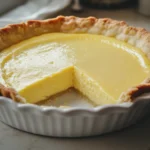
The Old Fashioned Custard Pie
- Total Time: 1 hour 30 minutes
- Yield: 8 servings 1x
Description
This classic Old Fashioned Custard Pie features a silky smooth, vanilla-infused custard filling in a flaky homemade crust. A beloved American dessert that’s stood the test of time, this simple but elegant pie relies on quality ingredients and careful technique to create something truly special. Perfect for holidays, family gatherings, or anytime you crave a slice of nostalgic comfort.
Ingredients
- 1 1/4 cups all-purpose flour
- 1/4 teaspoon salt
- 1/3 cup cold unsalted butter, cubed
- 1/4 cup cold vegetable shortening, cubed
- 3–4 tablespoons ice water
- 2 1/2 cups whole milk
- 4 large eggs
- 2/3 cup granulated sugar
- 1/4 teaspoon salt
- 1 1/2 teaspoons pure vanilla extract
- 1/4 teaspoon freshly grated nutmeg, plus more for garnish
- 1 tablespoon unsalted butter, melted and cooled
Instructions
- In a large bowl, combine flour and salt. Add cold cubed butter and shortening.
- Using a pastry cutter or fingertips, work the fats into the flour until the mixture resembles coarse crumbs with some pea-sized pieces remaining.
- Sprinkle ice water over the mixture, 1 tablespoon at a time, tossing with a fork until the dough begins to hold together when pressed.
- Form the dough into a disk, wrap in plastic, and refrigerate for at least 1 hour.
- Preheat oven to 375°F (190°C).
- Roll chilled dough on a lightly floured surface to a 12-inch circle. Transfer to a 9-inch pie plate, trim excess leaving a 1-inch overhang, then fold under and crimp edges.
- Chill shaped crust for 30 minutes.
- Line chilled crust with parchment paper and fill with pie weights or dried beans. Bake for 15 minutes, then remove weights and parchment and bake 5-7 minutes more until bottom appears dry but not browned.
- While crust bakes, heat milk in a saucepan until small bubbles form around edges (do not boil).
- In a large bowl, thoroughly whisk eggs. Gradually add sugar and salt, whisking until mixture lightens slightly in color.
- Very gradually pour hot milk into egg mixture in a slow stream while whisking constantly.
- Add vanilla extract, nutmeg, and melted butter, whisking to combine.
- Strain mixture through a fine-mesh sieve into a clean bowl.
- Reduce oven temperature to 325°F (165°C).
- Pour strained custard into partially baked pie shell.
- Bake for 35-40 minutes, until custard is almost set but still slightly jiggly in center. A knife inserted 1 inch from center should come out clean.
- Cool completely on a wire rack, then refrigerate for at least 2 hours before serving.
- Dust with additional freshly grated nutmeg before serving if desired.
Notes
- The key to a perfect custard pie is gentle, slow baking. Don’t rush the process by using high heat.
- Whole milk provides the richest result, though 2% can be substituted.
- Custard is properly cooked when it’s set around edges but still has a slight jiggle in the center.
- Straining the custard is optional but highly recommended for the smoothest texture.
- For best flavor, use freshly grated nutmeg rather than pre-ground.
- Allow the pie to cool completely before refrigerating to prevent condensation from forming on the surface.
- This pie tastes even better after resting overnight in the refrigerator.
- Prep Time: 30 minutes
- Cook Time: 1 hour
- Category: Dessert
- Method: Baking
- Cuisine: American
Nutrition
- Serving Size: 1/8 pie
- Calories: 340
- Sugar: 21g
- Sodium: 220mg
- Fat: 21g
- Saturated Fat: 12g
- Unsaturated Fat: 8g
- Trans Fat: 0g
- Carbohydrates: 30g
- Fiber: 0g
- Protein: 7g
- Cholesterol: 145mg
Keywords: custard pie, old fashioned pie, vanilla custard, egg custard, homemade pie, traditional dessert, holiday pie

